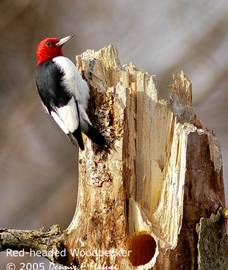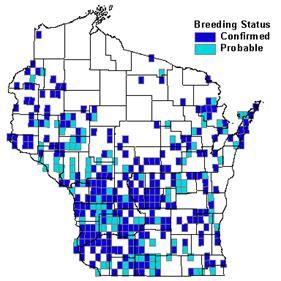Photo by Dennis Malueg


Status/Protection
- Global Rank: G5 Key to global and state ranks
- State Rank: S3B
- WBCI Priority: PIF, State Special Concern
Population Information
The Federal BBS information can be obtained at http://www.mbr-pwrc.usgs.gov/bbs/bbs.html by clicking on Trend Estimates and selecting the species in question. All estimates are for time period (1966-2005).
- Federal Breeding Bird Survey: significant decline
- Federal Breeding Bird Survey (WI): significant decline
- Federal Breeding Bird Survey (BCR 23): significant decline
- Federal Breeding Bird Survey (BCR 12): significant decline
- WSO Checklist Project: decline (1983-2007)
Life History
- Breeding Range: Atlantic Coast west to the Great Plains (Smith et al. 2000).
- Breeding Habitat: Oak Opening, Oak, Bottomland Hardwood, Sand Barrens, Northern Hardwood.
- Nest: Cavity in dead tree (snag) or dead limbs; often near open areas; ~2-25 meters above ground (Ehrlich et al. 1988, Smith et al. 2000).
- Nesting Dates: Eggs: mid-May to mid-June (Robbins 1991).
- Foraging: Swooping, ground foraging, bark gleaning, foliage gleaning (Ehrlich et al. 1988).
- Migrant Status: Short-distance migrant (some individuals overwinter every year, especially if acorns present) (Robbins 1991, Smith et al. 2000).
- Habitat use during Migration: Open deciduous woodland; grassland near woodland edge, any isolated mature deciduous trees (Smith et al. 2000).
- Arrival Dates: Some individuals are present all year; late April to late May for migrants (Robbins 1991).
- Departure Dates: Early September to early October (Robbins 1991).
- Winter Range: Similar to breeding range, but related to the abundance of oak mast (acorns).
- Winter Habitat: Similar to breeding habitat, also pine/oak woodlands in southern U.S. (Smith et al. 2000).
Habitat Selection
The Red-headed Woodpecker inhabits a wide variety of habitat types including deciduous woodlands, lowland and upland habitats, bottomlands, and residential areas (Smith et al. 2000). In Wisconsin this species often occurs in oak savanna, oak barrens, and other open upland sites with scattered trees (Mossman et al. 1991, Hansen and Mueller 2006). The Red-headed Woodpecker typically nests in dead trees or dead limbs of live trees, but also uses natural cavities, telephone poles, and other structures. King et al. (2007) found that Red-headed Woodpeckers selected snags and trees with greater dead limb length (6 m) compared to random trees. Cavities are often located in snags with no remaining bark. Preferred trees vary from ~30-90 centimeters DBH (diameter at breast height). The cavity is located from ~2-25 meters above ground, with most being located ~7-12 meters above ground (Smith et al. 2000).
Recent research conducted on golf courses suggests that urban areas could provide suitable Red-headed Woodpecker habitat if proper vegetation structure and composition are present. In this study, Red-headed Woodpeckers selected golf courses containing more dead limbs, snags, and hard-mast trees for nesting (Rodewald et al. 2005). Other authors also have noted the importance of stand-level characteristics at Red-headed Woodpecker nest sites. In Central Wisconsin, overall stand decadence around potential cavities may be more important than individual snag characteristics (King et al. 2007). In this study, Red-headed Woodpeckers nested in areas with greater basal area, cavity density, snag density, limb-tree density, and total dead limb length. Giese and Cuthbert (2005) also found that Red-headed Woodpeckers chose nest trees in patches containing high densities of potential nest trees.
Habitat Availability
Historically, oak savanna habitat covered approximately 16% of Wisconsin’s land area (Hansen and Mueller 2006). According to Cochrane and Iltis (2000), more than 99% of this plant community has been lost or altered. The few existing remnants in the state may be compromised due to over-grazing and/or isolation (WDNR 2005). Loss of snags and decadent stands of trees also impacts habitat suitability for this species (King et al. 2007). Fortunately, Red-headed Woodpeckers have shown positive responses to oak savannah restoration (Brawn 2006). Although Red-headed Woodpeckers are known to use residential and urban areas, the lack of suitable nesting substrate in these areas is likely limiting (Smith et al. 2000).
Population Concerns
This species is in decline over its entire range. There has been a 50-55% decline nationwide (Melcher 1998), and approx. 60-70 % in Wisconsin (Mueller 2001, 2002a and 2002b). The most recent Breeding Bird Survey data corroborate these findings, indicating significant declines range-wide and within Wisconsin (Sauer et al. 2005). The Wisconsin Breeding Bird Atlas (1995-2000) showed this species to be relatively widespread in the state. During the six-year census period, Atlas observers confirmed breeding on 22% of the surveyed quads (Hansen and Mueller 2006).
Loss of snags, fire suppression, firewood harvest, ecological succession of open woodlands to closed-canopy woodlands, and vehicle-caused mortality are all significant issues, as is interference competition with the European Starling (Smith et al 2000, Mueller 2001, 2002a and 2002b, Hansen and Mueller 2006). Invasive shrubs, such as buckthorn, may degrade existing habitat and pose a threat to Red-headed Woodpeckers (WDNR 2005).
Recommended Management
Managing the Red-headed Woodpecker is best accomplished by protection of snags, removal of invasive shrubs, and the use of controlled burns and timber thinning in oak woodlands (WDNR 2005). Other methods include girdling some mature trees for snag “creation” in savanna areas, and restoring preferred ground-layer vegetation. It has been recognized however, that overall stand decadence also is important to restoring this species. Managers should limit strategies that negatively affect stand decadence, e.g., pruning dead limbs, conducting salvage timber harvests in areas with high levels of standing dead woody fuel (King et al. 2007). During harvest, managers should consider creating a clumped distribution by retaining active nest trees and a clump of surrounding dead and dying trees (Giese and Cuthbert 2003).
There is an excellent opportunity to manage for this species on smaller private lands, golf courses, and city parks as tract size had little effect on breeding abundance or success (Rodewald et al. 2004, Brawn 2006). Efforts should be made to inform individual homeowners and homeowner associations about the importance of snags and provide guidelines on snag retention. Additionally, there is a significant opportunity to build upon existing programs that encourage private landowners to manage woodlots in ways that promote this species (King and Mueller 2005; see also http://www.wnrmag.com/stories/2005/aug05/red.htm). Conservation and management strategies for this species should be focused in the following ecological landscapes: Central Sand Hills, Southwest Savanna, Western Coulee and Ridges, and Western Prairie (WDNR 2005). Within these landscapes, Necedah National Wildlife Refuge and Fort McCoy are two important conservation sites for Red-headed Woodpeckers.
Research Needs
More research is needed to determine preferred nest site characteristics for this species, particularly in Wisconsin. Studies investigating interference competition with European Starlings are underway (see http://www.wisconsinbirds.org/Cavitynesters.htm). Research into diseases and contamination may elucidate other factors in their continuing decline. The importance of mast abundance (acorn production) warrants further study. The use of treated utility poles by the Red-headed Woodpecker and subsequent contamination of eggs has not yet been studied in Wisconsin. More information regarding the impact of invasive shrubs on this species would help to guide future management efforts (Mueller 2002a, Smith et al 2000).
Information Sources
- Chequamegon National Forest Bird Survey (NRRI) species account: http://www.nrri.umn.edu/mnbirds/accounts/RHWOa2.htm
- Richard Connor – Southern Research Station, Box 7600 SFASU, Nacogdoches, TX 75962;
- Cornell Lab RHWO page: http://www.birds.cornell.edu/bow/rehwoo/
- Danny Ingold – Professor, Dept. of Biological Sciences, Muskingum College, New Concord OH; ingold@muskingum.edu
- Richard King - Wildlife biologist, Necedah NWR, Necedah, WI richard_s_king@fws.gov
- William P. Mueller – Independent researcher, Milwaukee, WI; 414-643-7279, iltlawas@earthlink.net
- Nicolet Northern Forest Bird survey map: http://www.uwgb.edu/birds/nnf/species/RHWO.htm
- North American Breeding Bird Survey: www.npwrc.usgs.gov
- Temple S.A., J.R. Cary, and R. Rolley. 1997. Wisconsin Birds: A Seasonal and Geographical Guide. Wisconsin Society of Ornithology and Wisconsin Department of Natural Resources, Madison, WI.
- TNC – species management abstract http://conserveonline.org/2001/05/m/en/rhwo.doc
- Wisconsin Breeding Bird Atlas: www.uwgb.edu/birds/wbba/
References
- Brawn, J.D. 2006. Effects of Restoring Oak Savannas on Bird Communities and Populations. Conservation Biology 20(2): 460-469.
- Davis, M.A., D.W. Peterson, P.B. Reich, M. Crozier, T. Query, E. Mitchell, J. Huntington, and P. Bazakas. 2000. Restoring savanna using fire: impact on the breeding bird community. Restor. Ecol. 8(1): 30-40.
- Ehrlich, P.R., D.S. Dobkin, and D. Wheye. 1988. The birders handbook: a field guide to the natural history of North American birds. Simon & Schuster, Inc. New York.
- Giese, C.L.A. and F.J. Cuthbert. 2003. Influence of surrounding vegetation on woodpecker nest tree selection in oak forests of the Upper Midwest, USA. Forest Ecology and Management 179: 523-534.
- Hansen, K. and W.P. Mueller. 2006. Red-headed Woodpecker. In Wisconsin Breeding Bird Atlas (N.J. Cutright, B.R Harriman, R.W Howe, eds.). The University of Wisconsin Press: Madison, WI.
- King, R. 2003. Woody’s revival. Birdscapes, spring/summer: 24.
- King, R.S. and W.P. Mueller. 2005. The return of the loud redheads. Wisconsin Natural Resources Magazine. See also: http://www.wnrmag.com/stories/2005/aug05/red.htm
- King, R.S., K.E. Brashear, and M. Reiman. 2007. Red-headed Woodpecker nest-habitat thresholds in restored savannas. Journal of Wildlife Management 71(1): 30-35.
- Melcher, B. 1998. Red-headed Woodpecker. Pp. 250-251. In Colorado Breeding Bird Atlas (H.E. Kingery, ed.). Colorado Breeding Bird Atlas Partnership and Colorado Div. Wildl., Denver.
- Mossman, M.J., E. Epstein, and R.M. Hoffman. 1991. Birds of Wisconsin pin and oak barrens. Passenger Pigeon 53(2): 137-163.
- Mueller, W.P. 2001. Vehicle-caused mortality and the Red-headed Woodpecker in Wisconsin. Pass. Pigeon 63(4): 261-263.
- ___________. 2002a. The biogeography and recent decline of the Red-headed Woodpecker in Wisconsin. Unpublished master’s thesis. University of Wisconsin-Milwaukee.
- ___________. 2002b. The population decline of the Red-headed Woodpecker in Wisconsin and Illinois. Meadowlark 11(4): 130-132.
- Robbins, S.D. 1991. Wisconsin Birdlife: Population & Distribution, Past & Present. Univ. of Wisconsin Press, Madison, WI.
- Rodewald, A.D., P.G. Rodewald, and M.J. Santiago. 2004. Conservation of red-headed woodpeckers on Midwestern golf courses. USGA Turfgrass and Environmental Research Online. Volume 3, No. 15.
- Rodewald, P.G., M.J. Santiago, and A.D. Rodewald. 2005. The role of midwestern golf courses in the conservation of red-headed woodpeckers. Wildlife Society Bulletin 33: 448-453.
- Sauer, J.R., J.E. Hines, and J. Fallon. 2005. The North American Breeding Bird Survey, Results and Analysis 1966 - 2005. Version 6.2.2006. USGS Patuxent Wildlife Research Center, Laurel, MD.
- Smith, K.G., J.H. Withgott, and P.G. Rodewald. 2000. Red-headed Woodpecker (Melanerpes erythrocephalus), in A. Poole and F. Gill, eds. The Birds of North America. No. 518. The Birds of North America, Inc., Philadelphia, PA.
- Wisconsin Department of Natural Resources (WDNR). 2005. Wisconsin’s Strategy for Wildlife Species of Greatest Conservation Need. Madison, WI.
Contact Information
- Compiler: William P. Mueller, 414-643-7279, iltlawas@earthlink.net
- Editors: Rich King, USFWS, Richard_s_king@fws.gov | Kim Kreitinger, K.Kreitinger@gmail.com
